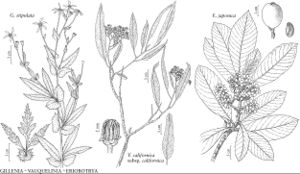Eriobotrya
Trans. Linn. Soc. London 13: 96, 102. 1821.
| Taxon | Illustrator ⠉ | |
|---|---|---|
 | Gillenia stipulata Vauquelinia californica subsp. californica Eriobotrya japonica | Marjorie C. Leggitt Marjorie C. Leggitt Marjorie C. Leggitt |
Shrubs or trees, 40–100 [–200] dm. Stems ca. 1, erect; bark gray-brown; short-shoots absent; unarmed; hairy. Leaves persistent, cauline, simple; stipules deciduous or ± persistent, free, linear, small, margins entire; petiole present; blade ± elliptic to oblong-lanceolate, 2–40 cm, leathery, margins flat, dentate, venation pinnate (craspedodromous), abaxial surface tomentose, adaxial glabrous [hairy]. Inflorescences terminal, 20–40-flowered, panicles, usually ± tomentose; bracts present at proximal nodes, leafy; bracteoles present. Pedicels present, short, or nearly absent. Flowers: perianth and androecium epigynous, 15–20 mm diam.; hypanthium urceolate, 3–4 mm, usually tomentose; sepals 5, suberect, triangular; petals 5, white, obovate to ± oblong; stamens [10–15] 20, shorter than petals; carpels (2–) 5, connate, basally adnate to hypanthium, indumentum not recorded, styles (2–) 5, terminal, proximally connate; ovules 2. Fruits pomes, soft apricot-yellow [yellow to reddish or blackish], ellipsoid to subglobose, [10–] 20–30 mm diam., softly short-hairy; hypanthium persistent; sepals usually persistent, covering hypanthial opening or reflexed; carpel walls thin; styles not persistent. Seeds 1–5 per fruit. x = 17.
Distribution
Introduced; s, se Asia, also in Mexico, West Indies, Central America, South America, Europe, n, s Africa, Pacific Islands (New Zealand), Australia
Discussion
Species ca. 30 (1 in the flora).
Eriobotrya is distinctive in Maleae; among other attributes it contains the largest plants in the subfamily with forest trees to 20 m and has pomes that do not have cores but have large seeds (J. R. Rohrer et al. 1991). Important regional revisions are by J. E. Vidal (1965) and Gu C. and S. A. Spongberg (2003c). The closest relation is Rhaphiolepis Lindley (D. Potter et al. 2007), in conformity with morphologic evidence. Eriobotrya japonica provides a delectable fruit. In addition to this species cultivated and escaped in the southern United States, E. deflexa (Hemsley) Nakai may be encountered in arboreta in the same area.
Selected References
None.
Lower Taxa
"thin" is not a number."dm" is not declared as a valid unit of measurement for this property.